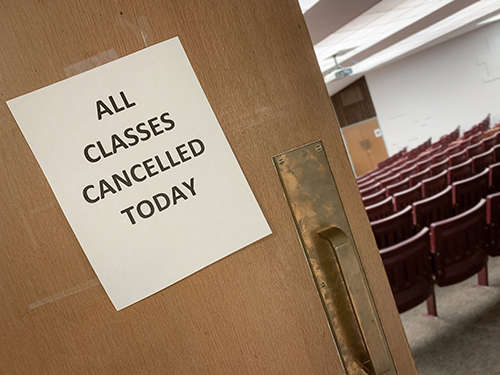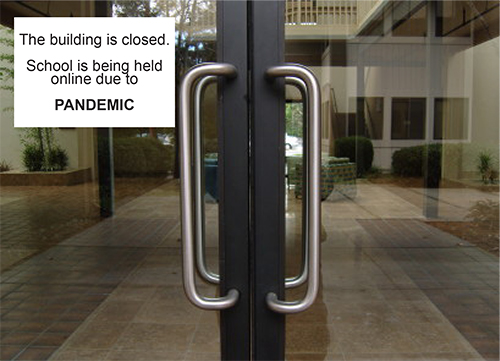
If only the future were clear.
If only everything were normal.
If only … But it’s not clear and it’s not normal.
Higher Education will rapidly change as it responds to the effects of the virus. A high priority has to be the health and safety of students, faculty, and staff, while at the same time trying to fulfill the institutional mission. Unfortunately, a number of financially fragile colleges and universities will not survive this disruptive time.
All colleges and universities plan in some way, often, if done comprehensively, with positive impact. Sometimes planning occurs because it is mandated; sometimes because it is part of a campus’s management style and culture; sometimes, to respond to a financial gift; sometimes because of a new president or provost. For whatever reason planning occurred in the past, today and in the foreseeable future, planning is essential. The Covid-19 pandemic has made it so.

The uncertainty of our current situation requires a comprehensive approach to planning that encompasses all aspects of an institution: students, faculty, staff, departments, degree programs, schedule, curriculum, pedagogy, IT, finances and fiscal resources, buildings, campus, athletics and recreation, student residences, and student services. The interdependencies are complex; but the health and safety of students and faculty will force the campus to prioritize its strategies and actions for moving forward especially in the context of financial realities.
What might planning look like today? It starts, as always, with the institution’s mission statement which describes the purpose and values of the college or university. It is the institution’s raison d’etre. In the pre-Covid past the next step would be the development of a strategic plan – a set of goals to reach an institutional vision, strategies to achieve the goals, and actions that support each strategy. But strategic plans usually have timelines of 5 to 10 years and what is needed are immediate plans for this summer, fall, and spring – and the year beyond.
Planning needs valid information, data, and an understanding of trends to be successful. It thrives on an environment of predictability. None of that exists in the present Higher Education situation. If a college decides to open in the fall, how many students will return? Will high school graduates apply or take a gap year? Will parents allow their child to attend? How can an institution change its physical spaces to provide social distancing? Will the dining hall allow social distancing? How many classroom seats will need to be removed to respect social distancing? What financial decisions will need to be made? What operational decisions?

With such uncertainty and so many unknowns, Scenario Planning is going to be one of the approaches that can provide a way forward. Scenario planning is a technique that makes assumptions about possible futures and develops strategies to respond. It is a planning process to support institutional decision makers given the uncertainty of predicting the immediate future.
Higher Education is tied to schedules. Critical institutional decisions have to be made by May, June, or July to allow an institution to prepare for the fall. Students have to make acceptance decisions earlier. In the plans about whether to open a campus in the fall or continue on-line for another semester, a number of institutions have announced June or July as a deadline to make that decision. Essentially, giving the college or university time to see some indication about which scenario, which future might become reality.

Best practice is to create or define four or five possible futures – scenarios. Do not think of Good, Fair, and Poor scenarios, but create realistic stories with sufficient detail that will allow you to create strategies to respond if any one of them become a reality.
Best practice is a deliberative planning process that often takes several months. It involves a committee comprised of administrators and other institutional representatives. The collaborative process involves discussions and workshops with many of the institution’s constituencies. Unfortunately, there isn’t sufficient time to spend months – only weeks to develop four or five scenarios and the focused strategies and actions in response. If the committee consists only of senior staff, it still must reach out to others to understand the implications of any scenario and strategy on all aspects of the college or university.
Institutions needs to focus and find a way to shorten the time but still create real strategies and actions that will respond to the scenarios. Depending on the scenario, some strategies must focus on quickly being able to adjust or change direction. Some actions must focus on keeping your students and faculty safe and well. The planning committee can actually define a number of scenarios that, if it makes sense, can be combined so that eventually, the number of scenarios will be more manageable.
Despite the necessity for speed, interaction and communication with key institutional representatives to help craft the strategies and actions is essential. Various academic and administrative personnel and departments will have to be linked to and responsible for the various actions that have been defined for each of the scenarios. Trigger points, based on events and data, will have to be identified that will alert the institution that a particular scenario is going to become reality.
On this date, May 11th 2020, the Chronicle of Higher Education had information for 278 colleges and universities about their plans for the fall. Institutions that were planning on opening in the fall represented 72 percent; those that were waiting to make a decision represented 17%; those that were considering various scenarios 4% were basically waiting to make a decision; hybrid approaches also totaled 4%; and the rest totaled 3%. Hopefully, those institutions that are planning for an in-person opening in the fall have thought through other scenarios that might potentially affect that choice.

Higher Education will survive this plague, this pandemic, just as it has in the past. Scenario planning is a tool to help a college or university think carefully about their mission and to quickly plan for the unknowable by crafting possible futures and related strategies and actions that will be necessary in response to whatever will happen in the fall and spring – and the year after, and the year after.

Arthur Lidsky
|





